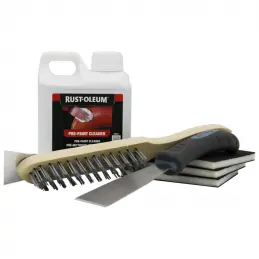- There are no more items in your cart
- Shipping Calculated at checkout
-
Sub-Total (inc. VAT)
£0.00
Sherwin Williams Zinc Clad IV EU (formerly known as Zinc Clad M501), is 2-pack epoxy zinc rich anti-corrosive primer for anti-corrosive protection of steel surfaces prepared by abrasive blast cleaning, and may be used as a repair primer for galvanized surfaces.
- Meets the performance requirements of ISO20340 (2009) as part of a three coat system
- Conforms to composition and performance requirements of Norsok M501 Rev.5 (2004) System 1
- HA Item No 109
- Do not overcoat with paints containing saponifiable resins such as oleo-resinous or alkyd based paints unless a non-saponifiable resin based barrier coat has been applied first
Sherwin Williams Zinc Clad IV EU, formerly known as Zinc Clad M501, is 2-pack epoxy zinc rich anti-corrosive primer for anti-corrosive protection of steel surfaces prepared by abrasive blast cleaning, and may be used as a repair primer for galvanized surfaces.
Do not overcoat with paints containing saponifiable resins such as oleo-resinous or alkyd based paints unless a non-saponifiable resin based barrier coat has been applied first.
Quick Links - Click To Jump To Section:
- Features & Benefits
- Endorsements
- Recommended Application Methods
- Product Characteristics
- Recommended Thickness
- Practical Application Rates
- Average Drying Times
- Application Equipment
- Recommended Topcoat
- Additional Notes
- Clean Up Instructions
- Surface Preparation
- Application Conditions
Features & Benefits
- 2-pack epoxy zinc rich anti-corrosive primer
- Anti-corrosive protection of steel surfaces prepared by abrasive blast cleaning
- May be used as a repair primer for galvanized surfaces
- Applied by airless spray
- Meets the performance requirements of ISO20340 (2009) as part of a three coat system
- Conforms to composition and performance requirements of Norsok M501 Rev.5 (2004) System 1
- HA Item No 109
- Do not overcoat with paints containing saponifiable resins such as oleo-resinous or alkyd based paints unless a non-saponifiable resin based barrier coat has been applied first.
Endorsements
- Meets the performance requirements of ISO20340 (2009) as part of a three coat system
- Conforms to composition and performance requirements of Norsok M501 Rev.5 (2004) System 1
- HA Item No 109
Recommended Application Methods
- Airless Spray
- Brush (for small areas and touch up only)
- Thinner / Clean Up: Cleanser/Thinner No. 5
Product Characteristics
- Flash Point:
- Base: 24°C/75 °F
- Additive: 24°C/75 °F
- Volume Solids: 61 ± 3% (ASTM-D2697-03)
- VOC:
- 311 gms/litre determined practically in accordance with UK Regulations PG6/23 379 gms/litre calculated from formulation to satisfy EC Solvent Emissions Directive 159 gms/kilo content by weight from formulation, to satisfy EC Solvent Emissions Directive
- Mix Ratio: 4 parts base to 1 part additive by volume
Recommended Thickness
| Minimum | |
|---|---|
| Dry microns (mils) | 60 (2.5) |
| Wet microns (mils) | 98 (4) |
| Theoretical Coverage m 2/L (sq ft/gal) | 9.84* (400) |
* This figure makes no allowance for surface profile, uneven application, overspray or losses in containers and equipment. Film thickness will vary depending on actual use and specification.
Practical Application Rates 
Microns Per Coat (Mils)
| Airless Spray | |
|---|---|
| Dry | 60* (2.5) |
| Wet | 98 (4) |
* Maximum sag tolerance typically 164μm wet (100μm ) (4.0 mils) dry by airless spray.
Average Drying Times
@ 98 microns (4 mils) wet:
| @ 5 ° C/41 °F | @ 15 ° C/59 °F | @ 23 ° C/74 °F | @ 35 ° C/95 °F | |
|---|---|---|---|---|
| To touch | 25 mins | 25 mins | 20 mins | 15 mins |
| To handle | 16 hours | 14 hours | 12 hours | 10 hour |
| To recoat | 6 hours | 5 hours | 4 hours | 3 hour |
| For overcoating information, refer to Recommended Topcoat section. | ||||
| Drying time is temperature, humidity, and fi lm thickness dependent. | ||||
| Pot Life | 10 hours | 8 hours | 4 hours | |
Application Equipment
The following is a guide. Changes in pressures and tip sizes may be needed for proper spray characteristics.
Always purge spray equipment before use with listed reducer.
Any reduction must be compliant with existing VOC regulations and compatible with the existing environmental and application conditions.
| Airless Spray: | |
|---|---|
| Nozzle Size | 0.38mm (15 thou) |
| Fan Angle | 20-30° |
| Operating Pressure | 115kg/cm 2 (1600 psi) |
The airless spray details given above are intended as a guide only.
Details such as fluid hose length and diameter, paint temperature and job shape and size all have an effect on the spray tip and operating pressure chosen.
However, the operating pressure should be the lowest possible consistent with satisfactory atomisation. As conditions will vary from job to job, it is the applicators' responsibility to ensure that the equipment in use has been set up to give the best results.
Recommended Topcoat
Indefinitely overcoatable with epoxy systems provided a minimum of 60 microns (2.5 mils) dft is obtained.
Do not overcoat with paints containing saponifiable resins such as oleo-resinous or alkyd based paints unless a non-saponifiable resin based barrier coat has been applied first.
Additional Notes
Drying times, curing times and pot life should be considered as a guide only.
The curing reaction of epoxies commences immediately the two components are mixed, and since the reaction is dependent on temperature, the curing time and pot life will be approximately halved by a 10°C/50°F increase in temperature and doubled by a 10°C/50°F decrease in temperature.
Exposure to Weathering
If Zinc Clad IV EU is exposed to the weather, there is a risk of the formation of zinc salts on the surface, which must be removed by fl ash blasting or washing down prior to overcoating, otherwise intercoat adhesion may be adversely affected.
The rate of zinc salt formation will vary from one location to another. Under severe conditions e.g. marine coastal, offshore or heavy industrial areas, it is strongly recommended that overcoating takes place within 7 days.
Epoxy Coatings - Tropical Use
Epoxy paints at the time of mixing should not exceed a temperature of 35°C/95°F. At this temperature the pot life will be approximately halved. Use of these products outside of the pot life may result in inferior adhesion properties even if the materials appear fit for application. Thinning the mixed product will not alleviate this problem.
The maximum air and substrate temperature for application is 50°C/122°F providing conditions allow satisfactory application and film formation. If the air and substrate temperatures exceed 50°C/122°F and epoxy coatings are applied under these conditions, paint fi lm defects such as dry spray, bubbling and pinholing etc. can occur within the coating.
Numerical values quoted for physical data may vary slightly from batch to batch.
Clean Up Instructions
Clean spills and spatters immediately with Thinner No.5. Clean tools immediately after use with Thinner No.5. Follow manufacturer's safety recommendations when using any solvent.
Surface Preparation
Blast clean to Sa2½ BS EN ISO 8501-1:2007 (SSPC-SP10/ NACE2) Average surface profi le in the range 50 - 75 microns (2.3 mills).
Ensure surfaces to be coated are clean, dry and free from all surface contamination.
For repair of galvanizing, for small areas, abrade the surface to a minimum standard of St3 BS EN ISO 8501-1:2007 (SSPC-SP3) feathering off the edges of intact galvanizing surrounding such areas, and then brush apply the primer. For large areas it is recommended that the surface is flash blasted.
Application Conditions
Epoxy paints should preferably be applied at temperatures in excess of 10ºC/50°F. In conditions of high relative humidity, ie 80-85% good ventilation conditions are essential. Substrate temperature shall be at least 3ºC/37°F above the dew point and always above 0°C/32°F.
At application temperatures below 10°C/50°F, drying and curing times will be signifi cantly extended, and spraying characteristics may be impaired.
Application at ambient air temperatures below 5°C/41°F is not recommended.
In order to achieve optimum water and chemical resistance, temperature needs to be maintained above 10ºC/50°F during curing.
Data sheet
- Manufacturer
- Sherwin Williams
- For Use By
- Industrial Use
- Water / Solvent Based
- Solvent
- For Use On
- Steel Ballast Tank Interiors
Steel Oil Storage Tank Interiors
Steel Fuel Storage Tanks
Steel External Coating
Masonry External Coating
Primary Containment
Secondary Containment
Cathodic Protection Systems - For Use On
- Steel Single and Multi-Coat Seawater Tanks
Masonry Single and Multi-Coat Seawater Tanks
Steel Fuel Tanks
Steel Bilge Tanks
Steel CHT Tanks
Wind Tower Gearbox Lining
Transformer Lining - Application Method
- Spray
- Single, Two or Three Pack
- Two-Pack
- Base Type
- Epoxy
- Minimum Applied Thickness
- Dry: 60 microns/2.5 mils; Wet: 98 microns/4 mils
- Solvent
- Mixture - see safety data sheet
- Mixing Ratio
- 4 parts base to 1 part additive by volume
- Key Features
- May be used as a repair primer for galvanized surfaces
- Coverage
- 9.84m2/L
- Recommended Thinner/Cleaner
- Cleanser/Thinner No. 5
- Unit Contents
- Base & Activator
- Compatible Topcoats
- Indefinitely overcoatable with epoxy systems provided a minimum of 60 microns (2.5 mils) dft is obtained.
- Solids by Volume
- 61 ± 3% (ASTM-D2697-03)
- VOC
- 311 gms/litre (UK); 159 gms/kilo content by weight (EC)
- Shelf Life (from date of manufacture)
- 18 months from date of manufacture or ‘Use By’ date where specified
- UN Number
- UN1263, UN3469
- Layer Thickness
- 164μm wet
- Dry to Recoat (at 23°C)
- 4 hours
- Touch Dry (at 23°C)
- 20 mins
- Dry to Handle (at 23°C)
- 12 hours
- Pot Life
- 8 hours (at 23c)
- Base Type
- Solvent-Based
- Base Type
- Epoxy
- Suitable For Use On
- Steel CHT Tanks
- Suitable For Use On
- Wind Tower Gearbox Lining
- Suitable For Use On
- Transformer Lining
- Suitable For Use On
- Steel
- Suitable For Use On
- Galvanised Steel
- Suitable For Use On
- Steel Ballast Tank Interiors
- Suitable For Use On
- Steel Oil Storage Tank Interiors
- Suitable For Use On
- Steel Fuel Storage Tanks
- Suitable For Use On
- Steel External Coating
- Suitable For Use On
- Masonry External Coating
- Suitable For Use On
- Primary Containment
- Suitable For Use On
- Secondary Containment
- Suitable For Use On
- Cathodic Protection Systems
- Suitable For Use On
- Steel Single and Multi-Coat Seawater Tanks
- Suitable For Use On
- Steel Fuel Tanks
- Suitable For Use On
- Steel Bilge Tanks
- Application Method
- Spray
- Usages
- Atmospheric
- Usages
- Anti-Corrosive
- Usages
- Zinc Rich /Cold Galvanising
- Product Usage Type
- Primer
- Product Range
- Zinc Clad
- Colour Family
- Grey
- Dry to Recoat (@ 20-25°C)
- 4 hours
Questions
Question about the product
Be the first to ask a question about this product!
IMPORTANT SHIPPING & DELIVERY INFORMATION
Sherwin Williams Zinc Clad IV EU is only available with the shipping and delivery timescales listed below - please do not contact our Customer Support Team with enquiries about alternative or earlier shipping and delivery times.
Saturdays and Sundays, as well as Bank Holidays, are not classed as working days.
Orders placed after the cut-off for this product will not be processed for earliest dispatch until 9am the next working day.
All delivery costs below are excluding VAT



